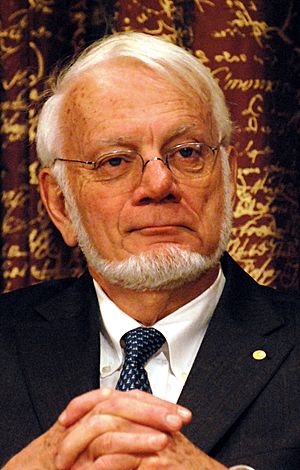Thomas A. Steitz facts for kids
Quick facts for kids
Thomas Steitz
|
|
|---|---|

Steitz in 2009
|
|
| Born |
Thomas Arthur Steitz
August 23, 1940 |
| Died | October 9, 2018 (aged 78) Branford, Connecticut, U.S.
|
| Alma mater | Wauwatosa High School, Lawrence University, Harvard University |
| Known for | Bio-crystallography |
| Spouse(s) | Joan A. Steitz |
| Children | 1 |
| Awards |
|
| Scientific career | |
| Fields |
|
| Institutions | Howard Hughes Medical Institute, Yale University, University of California, Berkeley |
| Thesis | The 6⁰A crystal structure of carboxypeptidase A (1967) |
| Doctoral advisor | William N. Lipscomb, Jr. |
| Other academic advisors | David M. Blow |
| Notable students | Nenad Ban |
Thomas Arthur Steitz (August 23, 1940 – October 9, 2018) was an American biochemist. Biochemists study the chemistry of living things. He was a professor at Yale University and worked at the Howard Hughes Medical Institute.
Steitz is famous for his important work on the ribosome. Ribosomes are like tiny factories inside cells. They build proteins, which are essential for life.
In 2009, Steitz won the Nobel Prize in Chemistry. He shared the award with Venkatraman Ramakrishnan and Ada Yonath. They were honored for their studies on the structure and function of the ribosome.
He also received the Gairdner International Award in 2007. This award recognized his discoveries about how the ribosome works. He showed that a part of the ribosome, called peptidyl transferase, uses RNA to do its job. He also found out how some antibiotics stop this process.
Contents
Early Life and Learning
Thomas Steitz was born in Milwaukee, Wisconsin. He loved chemistry from a young age. He studied chemistry at Lawrence University and graduated in 1962. In 2010, his university honored him by renaming its chemistry building the Thomas A. Steitz Hall of Science.
He earned his Ph.D. in biochemistry and molecular biology in 1966. This was at Harvard University. His mentor was William N. Lipscomb, Jr., who later won a Nobel Prize himself.
While at Harvard, Steitz helped figure out the detailed atomic structures of important molecules. These were some of the largest structures ever studied at that time.
After Harvard, Steitz did more research at the MRC Laboratory of Molecular Biology in England. This was from 1967 to 1970.
Discoveries and Career
In 1970, Thomas Steitz and his wife, Joan A. Steitz, both joined the faculty at Yale University. There, he continued his research into how cells work. He focused on understanding their structures.
Steitz worked with Peter Moore to study the ribosome. They used a method called X-ray crystallography. This method helps scientists see the tiny atomic structure of molecules. In 2000, they published their amazing findings in the journal Science. Their work showed the detailed atomic structure of a large part of the ribosome.
His research on the ribosome was very important. It helped us understand how proteins are made. This knowledge also helps in developing new medicines. For his groundbreaking work, Steitz received the Nobel Prize in Chemistry in 2009.
Steitz also helped start a company called Rib-X Pharmaceuticals. This company, now known as Melinta Therapeutics, works to create new antibiotics. These antibiotics are designed based on how the ribosome works.
Awards and Recognition
- Nobel Prize in Chemistry (2009)
- Elected a Foreign Member of the Royal Society (ForMemRS) in 2011
Personal Life
Thomas Steitz enjoyed spending time outdoors. He loved skiing, hiking, and gardening.
He was married to Joan A. Steitz, who is also a very respected molecular biologist at Yale. They lived in Branford, Connecticut. They had one son, Jon, and two grandchildren, Adam and Maddy. Thomas Steitz passed away on October 9, 2018, due to complications from pancreatic cancer treatment.
See also
- History of RNA biology
- List of RNA biologists
 In Spanish: Thomas Arthur Steitz para niños
In Spanish: Thomas Arthur Steitz para niños

